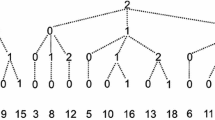Abstract
Exploiting our earlier results [J. Math. Chem. 4 (1990) 295–353 and 13 (1993) 273–316] on the unitary group U(n) Racah-Wigner algebra, specifically designed for quantum chemical calculations of molecular electronic structure, and the related tensor operator formalism that enabled us to introduce spin-free orbital equivalents of the second quantization-like creation and annihilation operators as well as higher rank symmetric, antisymmetric and adjoint tensors, we consider the problem of U(n) basis partitioning that is required for group-function type approaches to the many-electron problem. Using the U(n) ⊃ U(n 1) × U(n 2),n =n 1 +n 2 adapted basis, we evaluate all required matrix elements of U(n) generators and their products that arise in one- and two-body components of non-relativistic electronic Hamiltonians. The formalism employed naturally leads to a segmented form of these matrix elements, with many of the segments being identical to those of the standard unitary group approach. Relationship with similar approaches described earlier is briefly pointed out.
Similar content being viewed by others
References
W. Moffitt, Proc. R. Soc. London A210 (1951) 224, 245.
G.G. Balint-Kurti and M. Karplus, in:Orbital Theories of Molecules and Solids, ed. N.H. March (Clarendon Press, Oxford, 1974) pp. 250–310; R. Polák, Chem. Phys. 60 (1981) 287.
R. McWeeny, Proc. R. Soc. London A253 (1959) 242.
W. von Niessen, J. Chem. Phys. 55 (1971) 1948.
R.E. Christoffersen and G.M. Maggiora, Chem. Phys. Lett. 3 (1969) 419; D. Spangler and R.E. Christoffersen, Int. J. Quant. Chem. 17 (1980) 1075.
F.O. Ellison, J. Am. Chem. Soc. 85 (1963) 3540; P.J. Kuntz, in: Theoretical Models of Chemical Bond, Part 2, The Concept of the Chemical Bond, ed. Z.B. Maksic (Springer, Berlin, 1990) pp. 321–376.
F.A. Matsen and D.J. Klein, J. Phys. Chem. 75 (1971) 1860.
P.E. S. Wormer and A. van der Avoird, J. Chem. Phys. 57 (1972) 2498.
P.E.S. Wormer, in:Electron Correlation: Proc. Daresbury Study Weekend, 17–18 November 1979, ed. M.F. Guest and S. Wilson (Science Research Council, Daresbury Laboratory, Daresbury, Warrington, U.K., 1980) pp. 49–59.
J. Paldus, J. Chem. Phys. 61 (1974) 5321; in: Theoretical Chemistry: Advances and Perspectives, Vol. 2, ed. H. Eyring and D. Henderson (Academic Press, New York, 1976) pp. 131–290.
I. Shavitt, Int. J. Quant. Chem. S11 (1977) 131; S12 (1978) 5.
The Unitary Group for the Evaluation of Electronic Energy Matrix Elements, Lecture Notes in Chemistry, Vol. 22, ed. J. Hinze (Springer, Berlin, 1981).
R. Pauncz,Spin Eigenfunctions: Construction and Use (Plenum, New York, 1979) ch. 9.
M.A. Robb and U. Niazi, Comp. Phys. Rep. 1 (1984) 127.
S. Wilson,Electron Correlation in Molecules (Clarendon, Oxford, 1984) ch. 5.
F.A. Matsen and R. Pauncz,The Unitary Group in Quantum Chemistry (Elsevier, Amsterdam, 1986).
J. Paldus, in:Symmetries in Science, Vol. 2, ed. B. Gruber and R. Lenczewski (Plenum, New York, 1986) pp. 429–446.
J. Paldus, in:Mathematical Frontiers in Computational Chemical Physics, IMA Series, ed. D.G. Truhlar (Springer, Berlin, 1988) pp. 262–299; (b) I. Shavitt, ibid., pp. 300–349.
R. McWeeny,Methods of Molecular Quantum Mechanics, 2nd ed. (Academic, London and San Diego, 1989) ch. 10.
M.A. Robb and U. Niazi, Rep. Molecular Theory 1 (1990) 23.
J. Paldus, in:Methods in Computational Molecular Physics, Vol. 4, ed. S. Wilson and G.H.F. Diercksen (Plenum, New York, 1992) pp. 57–63 and references therein.
A.P. Jucys, I.B. Levinson and V.V. Vanagas,Mathematical Apparatus of the Theory of Angular Momentum (Inst. of Phys. and Math. of the Acad. of Sci. of the Lithuanian SSR, Mintis, Vilnius, 1960) in Russian (English transi.: Israel Program for Scientific Translations, Jerusalem, 1962 and Gordon and Breach, New York, 1964); A.P. Jucys and A.A. Bandzaitis, The Theory of Angular Momentum in Quantum Mechanics (Inst. of Phys. and Math. of the Acad. of Sci. of the Lithuanian SSR, Mintis, Vilnius, 1964) in Russian.
E. El Baz and B. Castel,Graphical Methods of Spin Algebras in Atomic, Nuclear and Particle Physics (Dekker, New York, 1972).
I. Lindgren and J. Morrison,Atomic Many-Body Theory (Springer, New York, 1982) ch. 3.
J. Paldus and M.J. Boyle, Phys. Rev. A22 (1980) 2299; M.J. Boyle and J. Paldus, ibid. A22 (1980)2316.
J. Paldus and M.J. Boyle, Phys. Scripta 21 (1980) 295.
M.D. Gould and J. Paldus, Int. J. Quant. Chem. 30 (1986) 327; (b) M. D. Gould, ibid. 30 (1986) 364.
H.S. Green, J. Math. Phys. 12 (1971) 2106; A.J. Bracken and H.S. Green, ibid. 12 (1971) 2099.
M.D. Gould, J. Math. Phys. 21 (1980) 444; 22 (1981) 15; 27 (1986) 1944.
M.D. Gould and G.S. Chandler, Int. J. Quant. Chem. 25 (1984) 1089; 26 (1984) 441 and references therein.
J. Paldus, M.-J. Gao and J.-Q. Chen, Phys. Rev. A35 (1987) 3197.
X. Li and J. Paldus, J. Math. Chem. 4 (1990) 295 (referred to as Part 1).
X. Li and J. Paldus, J. Math. Chem. 13 (1993) 273 (referred to as Part 11).
M.D. Gould, X. Li and J. Paldus, to be published.
Author information
Authors and Affiliations
Rights and permissions
About this article
Cite this article
Li, X., Paldus, J. Unitary group tensor operator algebras for many-electron systems. III. Matrix elements in U(n 1 +n 2) ⊃ U(n 1) × U(n 2) partitioned basis. J Math Chem 14, 325–355 (1993). https://doi.org/10.1007/BF01164475
Received:
Issue Date:
DOI: https://doi.org/10.1007/BF01164475




